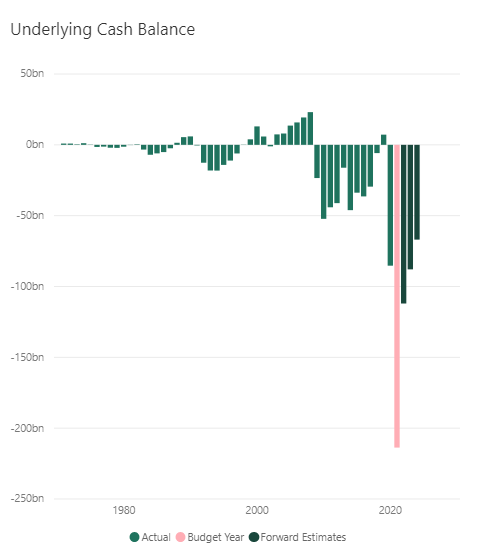The BIG assumption budget

The commentariat talk of living in unprecedented times with the economic impact of the response to the COVID 19 outbreak there for everyone to see. In response we have a Keynesian budget put in place to attempt to reverse those economic effects. A budget that, as late as at the end of last year was forecast to be in surplus, now has a forecast underlying cash deficit of $213.7b or 11% of GDP. There has been a significant increase in the forecast net debt levels now predicted to be in 2020-21 $703.2b or 36.1% of GDP. The cost of Government borrowing through bond issuance stands at around 0.12%. Unemployment is forecast to grow to 7%.
We have seen numbers like this before. In fact, higher numbers when comparing these numbers as a percentage of GDP. For example, gross debt of some 200% of GDP after World War II with a forecast for 2020-21 being 55%. Even in 1996-97 net interest payments as a percentage of GDP was 1.7%. Forecast for 2020-21 is 0.7%
So, could it be argued from an economic perspective, the budget position is not unprecedented. There is one key difference, however, to keep in mind. For the first time since the 1940s net migration is negative. That is more people are permanently leaving then coming to Australia. Where will economic growth in the short to medium term come from, with growth of the last 25 odd years being driven significantly by population growth fuelled by substantial positive net migration.
The government has proposed bringing forward and back dating tax cuts. Described by some as unfair but when unpacked shows that the top earners will bear more of a brunt as a percentage of the overall tax burden under the proposed arrangements. The question is will they be supported and get through the Senate.
Huge Infrastructure spending. Given the Constitution this will require the Feds and the states working together to identify and back winners. In the early days of the National Cabinet, established to deal with COVID, it could be argued that it appeared to have been working well. Quickly, however, as the crisis moved along, states started to look after their own. So, there is a risk.
Even with gross debt at 55% of GDP Australia compares very well, even when looking at other advanced economies positions prior to COVID. For example, as of December 2019 the following debt as a percentage of GDP existed; Japan 237%, Italy 135%, Singapore 126%, the USA 107%, France 98.1%, Canada 89.7%, United Kingdom 80.7%, and the European Union as a whole 79.3%.
Federal government budgets are a forecast with predictions based on a series of assumptions. An interesting addition to those assumptions for 20-21 Budget is the timing of a COVID 19 vaccine. Other assumptions, unemployment, inflation, productivity, investment may play out and modelling these is the Treasury’s bread and butter. Forecasting the development and rolling out of a vaccine is fundamentally different to modelling economic indicators. Having a budget that tries to guess this perhaps makes it “unprecedented”.
For more analysis, see Parbery’s data insights into the 2020-21 budget at this location: https://parbery.com.au/data/.


